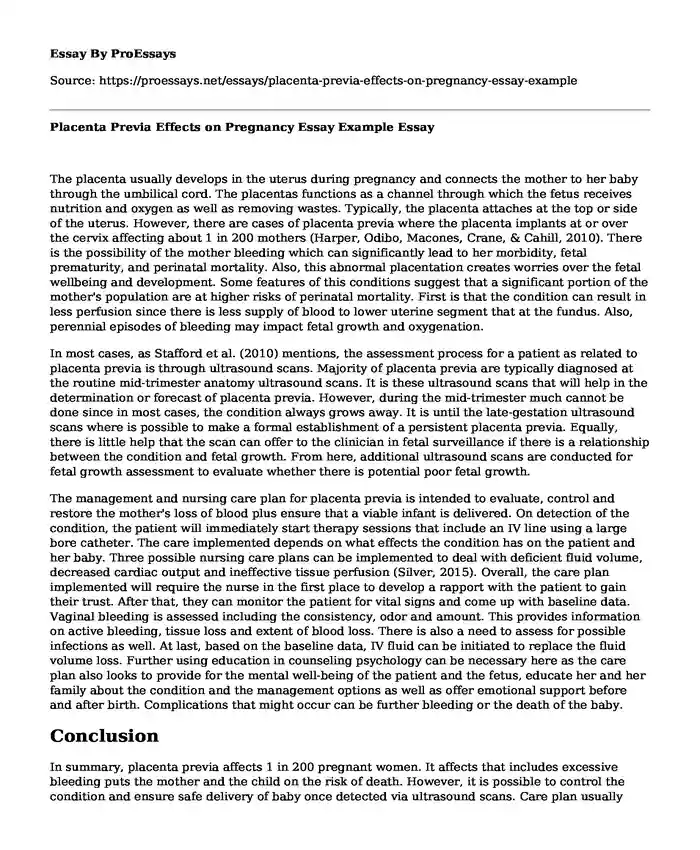The placenta usually develops in the uterus during pregnancy and connects the mother to her baby through the umbilical cord. The placentas functions as a channel through which the fetus receives nutrition and oxygen as well as removing wastes. Typically, the placenta attaches at the top or side of the uterus. However, there are cases of placenta previa where the placenta implants at or over the cervix affecting about 1 in 200 mothers (Harper, Odibo, Macones, Crane, & Cahill, 2010). There is the possibility of the mother bleeding which can significantly lead to her morbidity, fetal prematurity, and perinatal mortality. Also, this abnormal placentation creates worries over the fetal wellbeing and development. Some features of this conditions suggest that a significant portion of the mother's population are at higher risks of perinatal mortality. First is that the condition can result in less perfusion since there is less supply of blood to lower uterine segment that at the fundus. Also, perennial episodes of bleeding may impact fetal growth and oxygenation.
In most cases, as Stafford et al. (2010) mentions, the assessment process for a patient as related to placenta previa is through ultrasound scans. Majority of placenta previa are typically diagnosed at the routine mid-trimester anatomy ultrasound scans. It is these ultrasound scans that will help in the determination or forecast of placenta previa. However, during the mid-trimester much cannot be done since in most cases, the condition always grows away. It is until the late-gestation ultrasound scans where is possible to make a formal establishment of a persistent placenta previa. Equally, there is little help that the scan can offer to the clinician in fetal surveillance if there is a relationship between the condition and fetal growth. From here, additional ultrasound scans are conducted for fetal growth assessment to evaluate whether there is potential poor fetal growth.
The management and nursing care plan for placenta previa is intended to evaluate, control and restore the mother's loss of blood plus ensure that a viable infant is delivered. On detection of the condition, the patient will immediately start therapy sessions that include an IV line using a large bore catheter. The care implemented depends on what effects the condition has on the patient and her baby. Three possible nursing care plans can be implemented to deal with deficient fluid volume, decreased cardiac output and ineffective tissue perfusion (Silver, 2015). Overall, the care plan implemented will require the nurse in the first place to develop a rapport with the patient to gain their trust. After that, they can monitor the patient for vital signs and come up with baseline data. Vaginal bleeding is assessed including the consistency, odor and amount. This provides information on active bleeding, tissue loss and extent of blood loss. There is also a need to assess for possible infections as well. At last, based on the baseline data, IV fluid can be initiated to replace the fluid volume loss. Further using education in counseling psychology can be necessary here as the care plan also looks to provide for the mental well-being of the patient and the fetus, educate her and her family about the condition and the management options as well as offer emotional support before and after birth. Complications that might occur can be further bleeding or the death of the baby.
Conclusion
In summary, placenta previa affects 1 in 200 pregnant women. It affects that includes excessive bleeding puts the mother and the child on the risk of death. However, it is possible to control the condition and ensure safe delivery of baby once detected via ultrasound scans. Care plan usually intends to restore blood lost by the mother and ensure the safety of the baby. In a final assertion, it is worth mentioning that treatment equally provides for the parent psychological wellbeing.
References
Harper, L. M., Odibo, A. O., Macones, G. A., Crane, J. P., & Cahill, A. G. (2010). Effect of placenta previa on fetal growth. American journal of obstetrics and gynecology, 203(4), 330.
Silver, R. M. (2015). Abnormal placentation: placenta Previa, vasa Previa, and placenta accreta. Obstetrics & Gynaecology, 126(3),, 654-668.
Stafford, I. A., Dashe, J. S., Shivvers, S. A., Alexander, J. M., McIntire, D. D., & Leveno, K. J. (2010). Ultrasonographic cervical length and risk of hemorrhage in pregnancies with placenta previa. Obstetrics & Gynecology, 116(3), 595-600.
Cite this page
Placenta Previa Effects on Pregnancy Essay Example. (2022, Aug 23). Retrieved from https://proessays.net/essays/placenta-previa-effects-on-pregnancy-essay-example
If you are the original author of this essay and no longer wish to have it published on the ProEssays website, please click below to request its removal:
- Essay Sample on Clinician Nurses: Team Care for Optimal Clinical Outcomes
- Essay Example on Health Informatics Systems: Enhancing Acquisition, Storage, & Retrieval of Data
- 'Nursing Profession: Professional Ethics and Guiding Theories' - Essay Sample
- Essay Example on Global Crisis: The Unending Battle Against Disease
- 65-yo Woman, Bronchial Asthma, Severe Allergy: Moderate Persistent Asthma - Essay Sample
- Patient Safety: Achieving Zero Preventable Deaths - Essay Sample
- Free Essay Example: Impact of the Pandemic on the Economy







